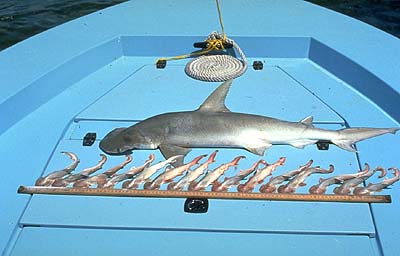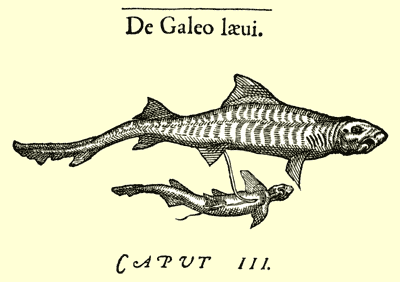
|
|
|
|
|
|
Shark Info (03-15-2000) |
Author |
|
Intro: |
Shark Info |
|
Main article: |
Andrew Cobb |
|
Article 1: |
Prof. H. Greven |
|
Article 2: |
Prof. M. S. Shivji |
|
Fact Sheet: |
Dr. E. K. Ritter |
|
Viviparous SharksEveryone talks about sharks, not only in connection with shark fin soup and potency products but also because of their mostly predatory habits and their alleged bloodthirsty character. In the process it is forgotten that almost 70% of all currently living sharks are intensely engaged in caring for their young and practice a form of brooding which we usually connect with mammals: To be precise the female keeps her developing eggs in the final section of the oviduct, called the womb or uterus, and following a long gestation period gives birth to fully developed, extremely independent pups, in other words, sharks give birth to living offspring. The long gestation period inside the mother's body effectively protects the young from enemies. In the following description I shall concentrate on the reproduction process of sharks, though much of the information also applies to their close relatives, the rays. Viviparous and oviparous sharks
The reproduction system of sharks is similar to that of other vertebrates - which is to be expected - but not of most bony fish species. The following is valid for all female sharks: As with human eggs, shark eggs move from the ovary into the oviduct which is clearly structured. First there is a funnel which catches the eggs. Then there is a segment which harbors the shell gland; a gland which is especially developed with oviparous species and serves to build up the compact, protective egg capsule. The area behind the shell gland merges into the final segment or womb. The oviduct also takes up the male's sperms. The eggs must, of course, be inseminated far up in the oviduct prior to reaching the shell gland, otherwise the sperms cannot permeate the egg shell produced by the shell gland. For the internal semination customary to shark reproduction, the pelvic fins of the males are actually a specially developed pair of erectable rods called claspers. With few exceptions, viviparous or oviparous sharks usually produce relatively few eggs but these have a substantial amount of egg yolk. Shark species which provide these eggs with an unusually resistant eggshell and lay them on the ocean floor are termed oviparous, while the eggs of viviparous species are very thin shelled. Importance of origin and type of foodEmbryonic development requires energy. Scientists distinguish between three methods of how such energy is gained: Oviparous sharks
Viviparous sharks
Obviously, when a mother shark provides her young with additional nourishment, this must not only reach them, they must also assimilate it. As we shall see, this takes place in different and sometimes even very unique ways. Johannes Müller, Steno, Rondelet and AristotelesThe first fundamental investigations into the reproduction system of viviparous sharks and the nourishing of their young in the womb stem from Johannes Müller (1801-1858), a German physiologist who by many is considered to be the founder of the scientific branch of zoology. The first to describe the feeding of embryos by their mother was, however, the Greek philosopher Aristoteles (384-322 BC) using the dusky smooth-hound (Mustelus canis) as an example. Aristoteles discovered the so-called yolk placenta and was able to differentiate between viviparous and oviparous sharks with their egg capsules. In his books on ocean fish published in 1554 ("Libri de piscibus marinis...") the French scientist and physician G. Rondelet (1507-1556) apparently based his depiction of a female shark - which was connected to its embryo / pup by an umbilical cord - on a description from Aristoteles.
The placenta of sharks was not rediscovered and redepicted until 1673 by the Danish anatomist N. Steno (1638-1686). Müller was familiar with these old works and he quoted them properly. However, contrary to his predecessors, he seemed to be more aware of their special significance and his own findings and thus presented them to the public in a manner which marks the beginning of more intense research on the reproduction and development of sharks and rays. Different forms of uterogestationThe Yolk PlacentaOnly an estimated 27% of all viviparous shark species have the specialized yolk placenta discovered by Aristoteles. During their development these embryos first eat up the yolk. Next, the very thin egg covering and the yolk placenta (portion of embryo on the yolk placenta) become so tightly interlocked with the uterus (portion of yolk placenta belonging to the female) through intricate creases that they are difficult to separate. This convoluted interlocking results in a very large contact surface which serves as a means of transporting nutrients (amino acids, sugar and fats) from the mother to the embryo. Embryonic waste products (e.g. urea) travel in the opposite direction into the mother's blood stream and are excreted by her body. The yolk placenta is connected to the embryo via a stem and serves as an umbilical cord containing blood vessels, as can be seen in Rondelet's drawing. Sharks whose embryos nourish themselves solely on egg yolk obviously do not have a yolk placenta. Embryos of the spiny dogfish (Squalus acanthias) can thus lose up to 55% of their organic substance during their development in the uterus, which is almost equivalent to the loss suffered by embryos of oviparous sharks. This is understandable since energy from the yolk not only influences the growth of the embryo, once used up it is not supplemented by any other energy. During gestation this form of embryonic nutrition means that the only function of the uterus is the exchange of respiratory gases and the transportation of water and salt. Uterus MilkWith many shark species the uterus can secrete a fluid (mostly via special protrusions) which bears the characteristic name of "uterus milk". Depending on the species, this type of milk has a varying amount of nutrients. For example, with the spiny dogfish (Squalus acanthias) this milk does not lead to more than a 1% increase in embryo weight, while with the antarctic dusky smooth-hound (Mustelus antarcticus) such weight increase can amount to 110%. Many other shark species can probably also transport nutrients from the uterus in addition to nourishing the embryo through the yolk placenta thanks to the oversized surface of the umbilical cord, e.g. the Atlantic sharp-nosed shark (Rhizoprionodon terraenovae). Cannibalism in the uterusEspecially dramatic is the method used by various mackerel shark species (Lamnidae) to nourish their embryos, e.g. the herring shark (Lamna nasus), and particularly the sand tiger shark (Carcharias taurus). It has been proven that the mackerels eat their eggs, while the sand tiger shark even feeds on other embryos, leaving only two per uterus which then also eat any unfertilized eggs (their filled stomachs were formerly thought to be a yolk sack). Conditions surrounding the sand tiger shark are better known. Initially, only one egg is found in each oviduct. Others follow and many are fertilized and even develop. A small percentage of the developing embryos form teeth and sensory organs prematurely (lateral line canal) and then devour the other unfertilized eggs and embryos until, in each case only one embryo per uterus, namely the strongest, remain. The young animals who eat the eggs and their siblings are extremely active in the uterus and snap at everything that crosses their path, even the hand of the researcher. There is every reason to talk about cannibalism in the uterus. Does uterogestation pay off?Considering the size and weight of the newborn, it appears that feeding on eggs or siblings is more effective than depending on the highly specialized yolk placenta. Young animals nourished with a yolk placenta increase their weight during development by "only" approximately 1000% [blue shark (Prionace glauca): 840%, dusky smooth-hound (Mustelus canis): 1050%], while the young who eat eggs and siblings (sand tiger shark, Carcharias taurus) increase their weight by 1,200,000%! Finally, after an astonishlingly long gestation period - varying between 6 and 22 months, depending on the species - viviparous sharks give birth to their pups. Depending on available yolk reserves, additional nourishment supplied by the mother and of course from its location in the uterus, the size of the newborn is usually between 45 and 60 cm - if one ignores extreme values. Newly born sand tiger sharks have an estimated length of 1 m and weigh up to 9 kg. In extreme cases, white sharks can bear young with a length of approx. 1.3 m. These are lengths which many adult bony fish species do not reach. Based on this, one can deduct that for young sharks the number of possible predators and rivals is reduced while the spectrum of prey is expanded. The advantages which those young sharks who eat their siblings or eggs have is clear: They are born large-sized, in part over one meter long, and to a certain extent as "experienced" predators. With all these advantages it appears that it is hardly necessary for sharks to bear numerous offspring. Actually, the number of newborn varies only between 2 and 40; occasional reports of more than 100 young (e.g. with the blunt-nose six-gill shark, Hexanchus griseus) are rare. The tendency of many shark offspring living in flat coastal waters to stay at due distance from adult sharks in more shallow "nurseries" where substantial prey is available, also offers a certain protection from their main enemies, the larger members of the same species and other sharks. It thus appears that giving birth to living offspring is a successful method of reproduction for sharks. Spontaneously, one would like to confirm this, considering that sharks have managed to survive for such a long time. The driving force behind the evolution of viviparous sharks is to a great extent unclear. An important prerequisite for this form of reproduction is, however, internal fertilization. Also noticeable is that all oviparous species living on the ocean floor and in coastal regions are not very large in size and that, contrary to viviparous sharks, they populate a greater spectrum of habitats. The species which live in the open sea and bear living offspring may be at an advantage because they need not search for suitable locations to lay their eggs. Most likely, however, even the young of such species gather in "nurseries". After man appeared on the scene, the shark's low reproduction rate combined with a relatively slow growth rate and late maturity - many species are not mature before 10 or 12 years - has turned out to be more of a disadvantage since any losses, such as those caused by overfishing, cannot be offset fast enough.
Additional Literature
* Prof. H. Greven H. Greven has been Professor of Zoology at Heinrich Heine University, Düsseldorf (Germany) since 1986. His workshop group deals mostly with comparative aspects of viviparousness with various invertebrates and vertebrates (nonmammals). May be published only by indicating the source: Shark Info / Prof. H. Greven |
|||||||||||||||||||||||||||||||||||||||||||||
|
|
|
|
|
|||||

